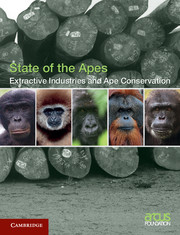Book contents
- Frontmatter
- Foreword
- Contents
- The Arcus Foundation
- Notes to readers
- Acknowledgments
- Photo
- Introduction
- Section 1
- 1 From global to local: the megatrends at the interface of apes and industry and the case of trade, law, and finance
- 2 Land tenure: industry, ape conservation, and communities
- 3 Ecological impacts of extractive industries on ape populations
- 4 Avoiding the chainsaws: industrial timber extraction and apes
- 5 Mining/oil extraction and ape populations and habitats
- 6 Artisanal and small-scale mining and apes
- 7 The bigger picture: indirect impacts of extractive industries on apes and ape habitat
- 8 Case studies of national responses to the impacts of extractive industries on great apes
- Section 2
- Annexes
- Acronyms and abbreviations
- Glossary
- References
- Index
3 - Ecological impacts of extractive industries on ape populations
Published online by Cambridge University Press: 05 June 2014
- Frontmatter
- Foreword
- Contents
- The Arcus Foundation
- Notes to readers
- Acknowledgments
- Photo
- Introduction
- Section 1
- 1 From global to local: the megatrends at the interface of apes and industry and the case of trade, law, and finance
- 2 Land tenure: industry, ape conservation, and communities
- 3 Ecological impacts of extractive industries on ape populations
- 4 Avoiding the chainsaws: industrial timber extraction and apes
- 5 Mining/oil extraction and ape populations and habitats
- 6 Artisanal and small-scale mining and apes
- 7 The bigger picture: indirect impacts of extractive industries on apes and ape habitat
- 8 Case studies of national responses to the impacts of extractive industries on great apes
- Section 2
- Annexes
- Acronyms and abbreviations
- Glossary
- References
- Index
Summary
Introduction
This chapter explores the significant threats and risks to apes, and their habitat, that result from the activities of extractive industries. All apes are protected by national and international laws throughout their geographic range. It is therefore illegal to kill, capture, or trade in either live apes or their body parts. It is important to understand where and how extractive industries affect great apes and their habitat during each phase of a project. In mining, oil, and gas projects (Chapter 5), these phases include exploration and evaluation, preliminary engineering and alternatives analysis, final engineering and site selection, construction and commissioning, operation, closure, and post-closure phases. All phases of all extractive industries are likely to have some impact on resident apes, although the scale and severity are likely to vary. Generally speaking, the behavior and physiology of wildlife are known to be impacted by human activities (Griffiths and van Schaik, 1993; Kinnaird and O'Brien, 1996; Woodford, Butynski, and Karesh, 2002; Blom et al., 2004a; Wikelski and Cooke, 2006; Rabanal et al., 2010; Ruesto et al., 2010; Chan and Blumstein, 2011). Species' responses to environmental disturbance will, however, vary according to their biological dispositions and the type and scale of disturbance. For example, species with highly specialized requirements may manifest significant adverse impacts, as found in studies looking at the impact of logging on terrestrial and bark-gleaning insectivorous birds or bats, while those with more general requirements may be less affected (Putz et al., 2001; Peters, Malcolm, and Zimmerman, 2006).
- Type
- Chapter
- Information
- Extractive Industries and Ape Conservation , pp. 64 - 99Publisher: Cambridge University PressPrint publication year: 2014



